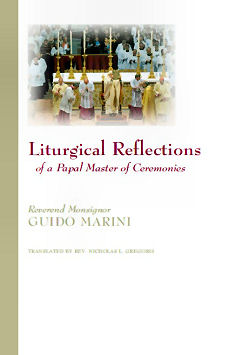
|
Posted March 25, 2011
Book: Liturgical Reflections of a Papal Master of Ceremonies Author: Rev. Msgr. Guido Marini Newman House Press. Pine Beach, NJ. 2011. Pp. 111 An Excerpt from the Preface:
Since assuming this role, Monsignor Marini has taken opportunities to explain why he makes the liturgical judgments he makes and how they are grounded in both sound theological principles and the goals of Pope Benedict XVI for the liturgical life of the whole church. Monsignor Marini has also taken to publishing on the Holy See’s Website short articles providing background on various aspects of the pontifical ceremonies. An Excerpt from the Book: The Crucifix as the Center of the Altar In Cardinal Ratzinger’s book Feast of Faith, which was first published in 1981, he presented the problem of the orientation of the altar in the context of the liturgical celebration. To cite here some passages of his test seems to me to be the most immediate way to understand the importance of his reflection and his proposal. “For the true location and the true context of the Eucharistic celebration is the whole cosmos. ‘Facing east’ makes the cosmic dimension of the Eucharist present through liturgical gesture. Because of the rising of the sun, the east — oriens — was naturally both a symbol of the Resurrection (and to that extent it was not merely a Christological statement but also a reminder of the Father’s power and the influence of the Hole Spirit) and a presentation of the hope of the Parousia. . .So, what has come down to us in the altar cross is a relic of the ancient eastward orientation. It maintained the ancient tradition of praying to the Lord Who is to come under the sign of the cross, a tradition with strong associations, in former times, with the cosmic symbol of the ‘east’. . .Even now, when the priest faces the people, the cross could be placed on the altar in such a way that both priest and people can see it. At the Eucharistic Prayer they should not look at one another; together they ought to behold Him, the Pierced Savior. . .(Zech 12:10; Rev 1:7). . .But the cross on the altar is not obstructing the view; it is the common point of reference. . . .I would even be so bold as to suggest that the cross on the altar is actually a necessary precondition for celebrating toward the people. It would help in clarifying the distinction between the Liturgy of the Word and the Liturgy of the Eucharist. The first is concerned with proclamation and hence with a direct, face-to-face situation, whereas the second is a matter of all of us worshiping together in response to the call Conversi ad Dominum — let us turn to the Lord; let us be converted to the Lord.” . . .”The idea that priest and people must look at each other in prayer is a novelty of modern Christianity and is completely foreign to ancient Christianity. Priest and people certainly do no pray facing one other, but facing the one Lord. Therefore, during prayer they look in the same direction: or toward the East as a cosmic symbol in expectation of the Lord Who is coming, or, where this is not possible, toward an image of Christ in the apse, toward a cross, or simply toward Heaven, as the Lord did in His High Priestly Prayer on the night before His Passion (Jn 17:1). In the meantime, the proposal I made at the end of the chapter about this topic in my work The Spirit of the Liturgy (pp. 83-84) is steadily making progress, namely, not to make any new changes, but simply to place the cross at the center of the altar, toward which the priest and faithful can look together, thus allowing themselves to be guided toward the Lord, Whom we beseech all together.” Table of Contents: Holy Communion The Pallium The Staff The Crucifix The Greek Gospel Silence Latin Beauty The Dalmatic |
|
